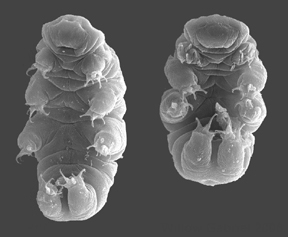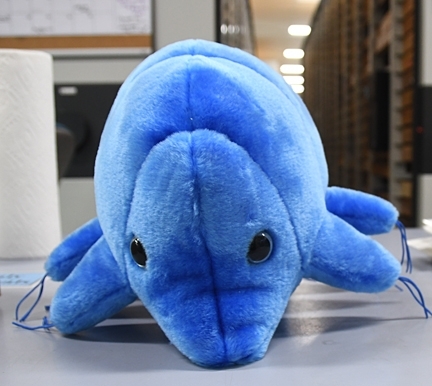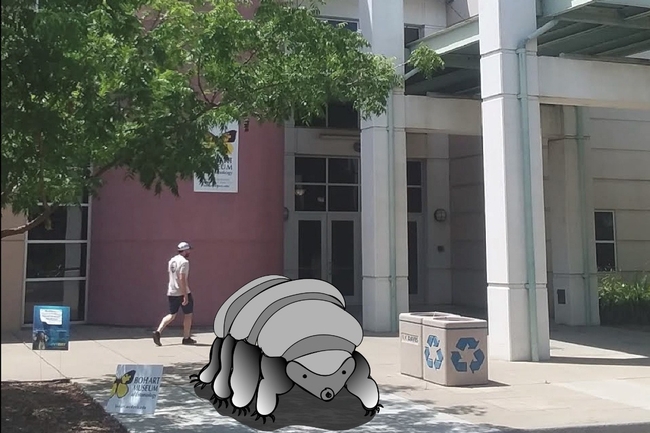
The Bohart Museum of Entomology at UC Davis boasts one of the world's largest tardigrade (water bear) collections, and what Lynn Kimsey wants to do, will certainly add to that point.
Kimsey, director of the Bohart Museum and UC Davis professor of entomology, plans to grace the entrance with a tardigrade sculpture, a concrete sculpture that will measure about 4 feet by eight feet.
"I've been in touch with the sculptor Solomon Bassoff (Faducciart) in Roseville," Kimsey said. "He did the caterpillar in the Davis Central Park."
"The reason for this is that we have one of the world's largest tardigrade collections, which was compiled by (senior museum scientist) Steve Heydon's predecessor, Bob Schuster," she said. "Tardigrades are really popular with kids in part because of their representation in the movies Ant-Man and Ant-Man and the Wasp, Star Trek and Family Guy."
Kimsey wrote about the tardigrades in her newsletter several years ago. The water bear "has to be one of the most peculiar and indestructible groups of animals known," she wrote. The microscopic and nearly indestructible tardigrade can survive being heated to 304 degrees Fahrenheit or being chilled for days at -328 F. And, even if it's frozen for 30 years, it can still reproduce." See video on EurekAlert.

The Bohart collection includes some 25,000 slide-mounted specimens. Kimsey and collaborator Carl Johannsen work on a National Science Foundation grant "to database and conserve" the collection.
"This collection is the result of years of collecting, mounting, imaging, and identifying by former collection manager Bob Schuster and emeritus professor Al Grigarick and their collaborators," she noted.
In appearance, the pudgy water bear seems as cuddly as a teddy bear. It has a barrel-shaped body and eight pudgy legs. The adults usually range from 0.3 to 0.5 mm in length.
German zoologist Johann August Ephraim Goeze (1731-1793) first described the critters in 1773, referring to them as "kleiner Wasserbär," or "little water bears."

They mostly feed on plants or bacteria "but some are predators on smaller tardigrades," Kimsey says. They use the stylets in their tubular mouth (snout) to pierce "individual plant or bacterial ells or small invertebrates."
Why is the water bear so indestructible? In research published in 2016, geneticist Takekazu Kunieda and his colleagues from the University of Tokyo found that the water bear expresses a tardigrade-specific protein that binds itself to DNA. This acts like a "shield against x-ray radiation, preventing the DNA from snapping apart," according to an article published in Gizmodo.
"Tardigrades are awesome," Kimsey said. "They can dry out completely and then become immortal. In fact, SpaceIL may have left thousands of dried tardigrades on the moon when it crashed earlier this year."
Stuffed toy water bears are also popular in the Bohart Museum's gift shop, which also includes insect-themed books, posters, t-shirts, jewelry, candy, and insect collecting equipment.
The museum, located in Room 1124 of the Academic Surge Building on Crocker Lane, houses nearly 8 million insect specimens, collected globally. It also maintains a live "petting zoo" featuring Madagascar hissing cockroaches, walking sticks and tarantulas.
And soon, there may very well be a tardigrade out front. The Bohart Museum Society has set up an account on Go Fund Me; see https://www.gofundme.com/f/waterbear-sculpture
Comments on Go Fund Me include:
- Great initiative that I am happy to support!
- Tardigrades were some of my childhood friends
- Favis seems like a great place for a tardigrade sculpture! I'm inspired by the tardigradologists & nematologists I've admired there. A eutardigrade seems like it'd be less prone to causing injuries, but I can support a heterotardigrade :)
- Robert Schuster, UCD Bohart Museum, was instrumental in my career studying tardigrades. He taught me how to identify the species (known at that time) and how to use the SEM. His tardigrade collection is housed in the Bohart Museum.
The Bohart Museum entrance may be "bare" today, but when a water bear arrives, one thing's for sure: kids and adults alike will love it "beary" much.
Attached Images:
